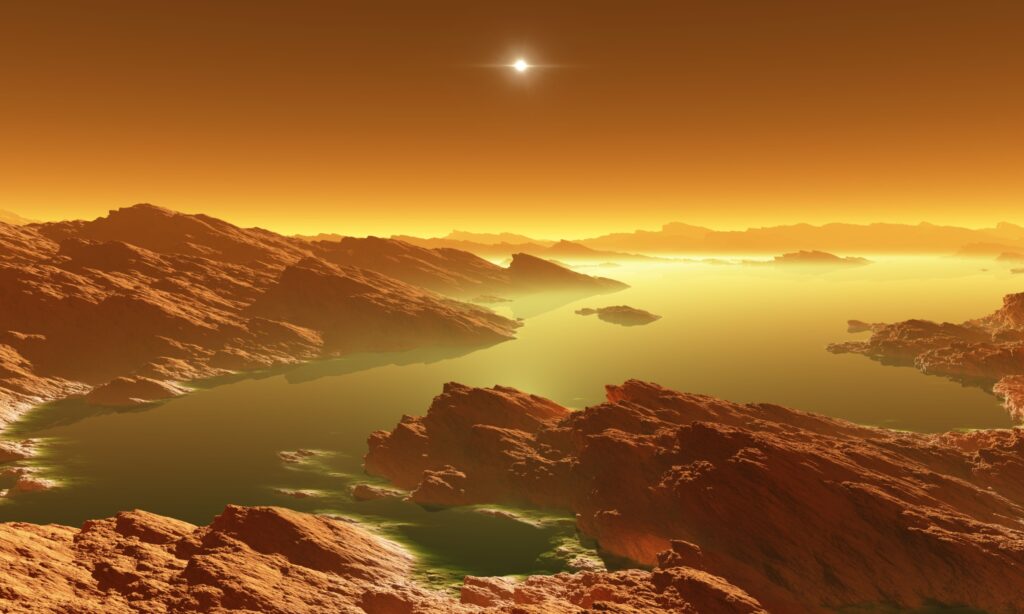
In the quest to discover life beyond Earth, few celestial bodies capture the imagination quite like Saturn’s largest moon, Titan. Unique in the solar system, Titan boasts surface lakes and seas, though these are composed not of water, but of liquid methane and ethane. This intriguing environment has led scientists to explore the possibility of life emerging under such alien conditions.
A recent study from NASA proposes a compelling scenario in which tiny compartments, known as vesicles—crucial in the early stages of cellular life—could naturally form within Titan’s frigid, hydrocarbon-rich lakes. This finding offers a potential pathway for life in an environment vastly different from Earth.
Vesicles in Titan’s Methane Lakes
On Earth, life began in water, where molecules assembled into structures, organized, and initiated the fundamental functions of living cells. One of the earliest steps in this process was the formation of vesicles. These small sacs, resembling tiny bubbles, are composed of amphiphilic molecules—molecules with one end that is hydrophilic and the other hydrophobic.
In water, these amphiphiles spontaneously form spheres, with the hydrophilic parts facing outward and the hydrophobic parts tucked inside. Over time, some of these spheres developed a bilayer membrane, providing a cellular structure capable of enclosing materials and shielding them from the external environment.
However, Titan’s environment is markedly different, lacking liquid water and presenting an entirely distinct chemical landscape. This is where the new research becomes particularly fascinating, suggesting that vesicles might form in Titan’s methane and ethane lakes through a different, yet natural, process.
Titan: A Moon with Weather
Not only is Titan Saturn’s largest moon, but it is also the only one with a dense atmosphere. This orange haze, primarily composed of nitrogen, also contains methane, which forms clouds, triggers rainstorms, and carves rivers and lakes into Titan’s icy surface—parallels to Earth’s water cycle.
NASA’s Cassini mission, which orbited Saturn from 2004 to 2017, provided unprecedented insights into Titan’s weather system. The mission revealed that methane on Titan undergoes a complete cycle of evaporation, condensation, and precipitation, driving complex atmospheric chemistry.
“The existence of any vesicles on Titan would demonstrate an increase in order and complexity, which are conditions necessary for the origin of life,” said Conor Nixon from NASA’s Goddard Space Flight Center in Greenbelt, Maryland.
Complex Organic Molecules on Titan
Sunlight breaks down methane molecules in Titan’s atmosphere, allowing them to recombine into more complex organic molecules. Some scientists speculate that this chemistry mirrors the processes on early Earth, offering a potential laboratory for understanding the origins of life.
The study delved into how vesicles might form under Titan-like conditions. Instead of water, researchers examined how droplets of liquid, propelled into the air by splashing methane raindrops, might interact with molecules coating the lake surfaces.
Making Vesicles in Titan’s Methane Lakes
Envision a droplet launched skyward, its surface layered with amphiphiles. Upon returning to the lake, which is similarly coated, the contact between the two layers creates a vesicle with a double-layered membrane, encapsulating the droplet within.
Imagine this process occurring repeatedly, resulting in the formation, dispersion, and interaction of thousands or millions of these vesicles. While not life itself, these structures could represent the chemical precursors to life.
Future Missions to Titan
Although this research remains theoretical, it marks a significant step in reimagining what life might resemble in extraterrestrial environments. NASA’s upcoming Dragonfly mission, though not targeting Titan’s lakes, will explore other surface areas, gathering data on Titan’s composition, atmosphere, and potential habitability.
While Dragonfly will lack the capability to directly detect vesicles, its findings may confirm whether Titan’s chemistry supports their existence. Such discoveries could bring us closer to answering the profound question of whether life can originate in environments unlike our own.
The study is published in the International Journal of Astrobiology.
—
Like what you read? Subscribe to our newsletter for engaging articles, exclusive content, and the latest updates. Check us out on EarthSnap, a free app brought to you by Eric Ralls and Earth.com.






